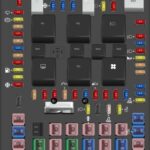Are you experiencing issues getting your 2014 Chevy Impala’s OBD2 system to show “ready” for emissions testing? This can be a frustrating problem, preventing you from passing inspection even if your car seems to be running fine. Understanding why your OBD2 monitors are not setting and how to address it is crucial. This guide will walk you through common causes and troubleshooting steps to get your 2014 Impala ready for its emissions test.
Understanding OBD2 Readiness Monitors
OBD2 (On-Board Diagnostics II) systems are designed to monitor your vehicle’s emissions systems and ensure they are functioning correctly. Readiness monitors are specific tests that the OBD2 system performs to verify these systems. For a 2014 Chevy Impala, these monitors must be in a “ready” state to pass an emissions test in many regions. Common monitors include:
- Catalyst Monitor: Checks the efficiency of the catalytic converter.
- Oxygen Sensor Monitor: Tests the functionality of the oxygen sensors.
- Evaporative System Monitor: Evaluates the evaporative emissions control system for leaks.
- EGR System Monitor (if applicable): Monitors the exhaust gas recirculation system.
- Secondary Air System Monitor (if applicable): Checks the secondary air injection system.
- Heated Catalyst Monitor (if applicable): Tests the heated catalytic converter.
If these monitors are not “ready,” it indicates that the OBD2 system hasn’t completed its self-tests for these components.
Common Reasons for OBD2 Monitors Not Ready on a 2014 Impala
Several factors can prevent OBD2 monitors from setting to “ready” on your 2014 Chevy Impala:
-
Recent Battery Disconnection or Replacement: Disconnecting or replacing your car battery resets the OBD2 system and clears all readiness monitors. After a battery event, you’ll need to perform a drive cycle to allow the monitors to reset.
-
Fault Codes and Check Engine Light (CEL): If your Impala has any active fault codes or a lit Check Engine Light, readiness monitors will often not run or set. Addressing and resolving any underlying issues causing fault codes is the first step. Use an OBD2 scanner to check for codes.
-
Interrupted Drive Cycles: OBD2 monitors typically set during specific driving conditions known as a “drive cycle.” If your driving patterns are mostly short trips or you don’t complete the necessary conditions, monitors may not set.
-
Underlying Mechanical or Electrical Issues: Problems with sensors, wiring, vacuum leaks, or other components within the emissions system can prevent monitors from completing their tests successfully.
-
PCM/ECM Issues: In rare cases, a problem with the Powertrain Control Module (PCM) or Engine Control Module (ECM) itself could hinder the OBD2 system’s operation.
Troubleshooting Steps
Here’s a step-by-step approach to troubleshoot OBD2 readiness issues on your 2014 Chevy Impala:
-
Check for Fault Codes: Use an OBD2 scanner to read any Diagnostic Trouble Codes (DTCs). Address any fault codes present. Clearing codes without fixing the underlying problem will only temporarily reset the CEL and the monitors will likely remain unset or return to “not ready” soon after.
-
Perform a Drive Cycle: A drive cycle is a specific sequence of driving conditions designed to allow the OBD2 monitors to run and complete their tests. While a specific drive cycle for a 2014 Impala may be available online or in the service manual, a general OBD2 drive cycle often involves:
- Cold Start: Start the vehicle with a cold engine (engine coolant temperature below 122°F and within 11°F of ambient temperature).
- Idle: Idle the engine for approximately two and a half minutes without touching the accelerator.
- Acceleration: Accelerate smoothly to 45-50 mph and maintain this speed for about eight minutes.
- Deceleration: Decelerate and come to a stop without using the brakes if possible. Let the vehicle coast down to 20 mph, then brake gently to a stop.
- Idle: Idle for five minutes with the vehicle stopped.
It may take multiple drive cycles over several days to set all monitors. Vary your driving conditions and include highway and city driving.
-
Inspect for Mechanical Issues: Check for any obvious mechanical problems that could affect emissions, such as vacuum leaks, exhaust leaks, or damaged wiring to sensors.
-
Check Battery and Charging System: Ensure your battery is in good condition and the charging system is functioning correctly. Low voltage or battery issues can sometimes affect OBD2 system operation.
-
Professional Scan and Diagnosis: If you’ve performed drive cycles and checked for basic issues but the monitors are still not ready, it’s advisable to take your 2014 Impala to a qualified mechanic or dealership. They have advanced diagnostic tools and expertise to pinpoint the underlying cause, which could range from faulty sensors (like oxygen sensors, MAF sensor, etc.) to more complex issues.
Emissions Testing and “Not Ready” Monitors
In many locations, vehicles are allowed to have one or two monitors “not ready” and still pass emissions testing, particularly for older models. However, it’s essential to check your local emissions testing regulations to understand the specific rules for your 2014 Chevy Impala. If you’ve genuinely addressed any underlying issues and monitors persistently remain unset after extensive driving, you may need to seek a referee inspection or explore options allowed by your local regulations, as mentioned in the original article, although patience and proper diagnosis are usually the key to resolving OBD2 readiness problems.
By following these troubleshooting steps, you can systematically address the issue of OBD2 monitors not being ready on your 2014 Chevy Impala and ensure your vehicle is ready for emissions testing.
